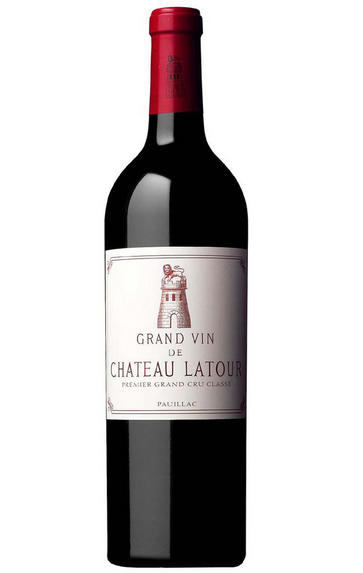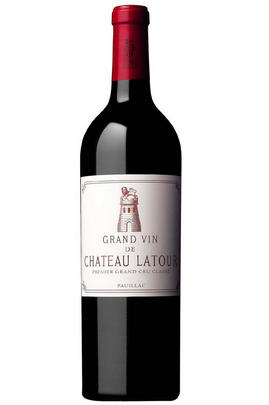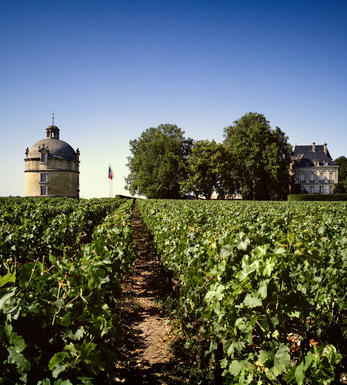
1996 Château Latour, Pauillac, Bordeaux

Critics reviews
Beautifully ornate nose with equal parts stalk, leaf, herb and black fruit. Freshly balanced palate with delicacy and refreshment, and surprising elegance for Pauillac from a big vintage. Wonderful complexity on the finish, earthy and open and meaty on the length.
Drink 2015-2035
Richarf Hemming MW, jancisrobinson.com (May 2018)
Lisa Perrotti-Brown - 28/02/2019
Inky black even at 25 years old. A hugely impressive wine, with plenty of chewy tannins still in play, ripples of cassis, bilberry and blackberry fruits, set against olive paste, charcoal and eucalyptus. Things have softened around the edges no question, this is still full of life with decades ahead of it, but this is a great moment to start enjoying its promise. Textbook Latour in many ways, for its austerity and power, and its serious character that is underlaid by concentrated pleasure showcasing 'the gift of sub-gravel clays'. 56% of overall production in the first wine. 1% Petit Verdot completes the blend. Last released in 2014 as an ex-château wine.
Drink 2023-2040
Jane Anson, Decanter (Jan 2021)
A hot, dry August produced very concentrated grapes in 1996. However, it turned a bit rainy in mid-September through early October, making the vintage less consistent on the Right Bank and in Graves. But as the weather turned glorious from early October on, it was an amazing year for later-harvested Cabernet in the Médoc. There was new ownership at Latour by this time, and a new vat room was completed just prior to the harvest this year. The 1996 Latour is medium to deep garnet in color with a profound earthy, meaty, gamey nose with hints of blueberry preserves, crème de cassis and pencil shavings. The palate is full-bodied, concentrated and packed with muscular fruit, with a firm, ripe, grainy backbone and epically long finish. Showing much more youthfully than the 2000 tasted on the same day and still possessing bags of youthful fruit in the mid-palate, this beauty is going to go on and on!
Lisa Perrotti-Brown, robertparker.com (Feb 2019)
About this WINE

Château Latour
Château Latour is a wine estate in Pauillac, part of the Haut-Medoc sub-region on the Left Bank of Bordeaux. The estate’s history dates back to at least the 14th century, though vineyards were not established here until the 17th century. The estate is located at the southern edge of the Pauillac appellation, bordering the St Julien vineyards of Château Léoville Las Cases. Latour is one of the five First Growths of the 1855 classification, occupying the top tier alongside Châteaux Lafite Rothschild, Margaux, Haut-Brion, and Mouton Rothschild.
Latour is owned by François Pinault, one of France’s wealthiest people. It forms the jewel in the crown of Pinault’s Artémis Domaines, itself part of the larger Groupe Artémis. Other wineries within the portfolio include Clos de Tart and Domaine d’Eugénie in Burgundy; Château Grillet in the Rhône Valley; Champagne Jacquesson; Eisele Vineyard in California’s Napa Valley; and Maisons et Domaines Henriot, which includes holdings in Champagne, Burgundy, and Oregon.
The day-to-day running of Latour is entrusted to the dynamic Frédéric Engerer. Under his stewardship, a major programme of investment has taken place. In 2012, Latour announced that it would no longer offer its wines as part of the Bordeaux En Primeur campaign. Instead, the wines are kept at the estate until such a time as they are ready to be opened and enjoyed. They are then offered through the La Place de Bordeaux distribution system several years after the vintage.
There are three wines produced here. Château Latour, the grand vin, is produced from vines immediately surrounding the château, from the vineyard area known as L’Enclos. Les Forts de Latour, the second wine, was created in 1966. It is now regarded as a great wine in its own right, certainly worthy of Classified Growth status. A third wine, Pauillac de Latour, is usually the product of young vines.
The vineyard is planted to a majority of Cabernet Sauvignon, along with some Merlot and small amounts of Cabernet Franc and Petit Verdot.

Pauillac
Pauillac is the aristocrat of the Médoc boasting boasting 75 percent of the region’s First Growths and with Grand Cru Classés representing 84 percent of Pauillac's production.
For a small town, surrounded by so many familiar and regal names, Pauillac imparts a slightly seedy impression. There are no grand hotels or restaurants – with the honourable exception of the establishments owned by Jean-Michel Cazes – rather a small port and yacht harbour, and a dominant petrochemical plant.
Yet outside the town, , there is arguably the greatest concentration of fabulous vineyards throughout all Bordeaux, including three of the five First Growths. Bordering St Estèphe to the north and St Julien to the south, Pauillac has fine, deep gravel soils with important iron and marl deposits, and a subtle, softly-rolling landscape, cut by a series of small streams running into the Gironde. The vineyards are located on two gravel-rich plateaux, one to the northwest of the town of Pauillac and the other to the south, with the vines reaching a greater depth than anywhere else in the Médoc.
Pauillac's first growths each have their own unique characteristics; Lafite Rothschild, tucked in the northern part of Pauillac on the St Estèphe border, produces Pauillac's most aromatically complex and subtly-flavoured wine. Mouton Rothschild's vineyards lie on a well-drained gravel ridge and - with its high percentage of Cabernet Sauvignon - can produce (in its best years) Pauillac's most decadently rich, fleshy and exotic wine.
Latour, arguably Bordeaux's most consistent First Growth, is located in southern Pauillac next to St Julien. Its soil is gravel-rich with superb drainage, and Latour's vines penetrate as far as five metres into the soil. It produces perhaps the most long-lived wines of the Médoc.
Recommended Châteaux
Ch. Lafite-Rothschild, Ch. Latour, Ch. Mouton-Rothschild, Ch. Pichon-Longueville Baron, Ch. Pichon Longueville Comtesse de Lalande, Ch. Lynch-Bages, Ch. Grand-Puy-Lacoste, Ch, Pontet-Canet, Les Forts de Latour, Ch. Haut-Batailley, Ch. Batailley, Ch. Haut-Bages Libéral.

Cabernet Sauvignon Blend
Cabernet Sauvignon lends itself particularly well in blends with Merlot. This is actually the archetypal Bordeaux blend, though in different proportions in the sub-regions and sometimes topped up with Cabernet Franc, Malbec, and Petit Verdot.
In the Médoc and Graves the percentage of Cabernet Sauvignon in the blend can range from 95% (Mouton-Rothschild) to as low as 40%. It is particularly suited to the dry, warm, free- draining, gravel-rich soils and is responsible for the redolent cassis characteristics as well as the depth of colour, tannic structure and pronounced acidity of Médoc wines. However 100% Cabernet Sauvignon wines can be slightly hollow-tasting in the middle palate and Merlot with its generous, fleshy fruit flavours acts as a perfect foil by filling in this cavity.
In St-Emilion and Pomerol, the blends are Merlot dominated as Cabernet Sauvignon can struggle to ripen there - when it is included, it adds structure and body to the wine. Sassicaia is the most famous Bordeaux blend in Italy and has spawned many imitations, whereby the blend is now firmly established in the New World and particularly in California and Australia.


Buying options
Add to wishlist
Description
Latour is a model for consistancy and excellence in even the poorest of vintages. In a superb year like 1996 the results are heavenly! This is a textbook Latour, massively concentrated, rich, with polished tannins and full bodied without being heavy. The extraordinary power and balance of this wine is phenomenal. It should continue to evolve to 2030.
Berry Bros. & Rudd
wine at a glance
Delivery and quality guarantee